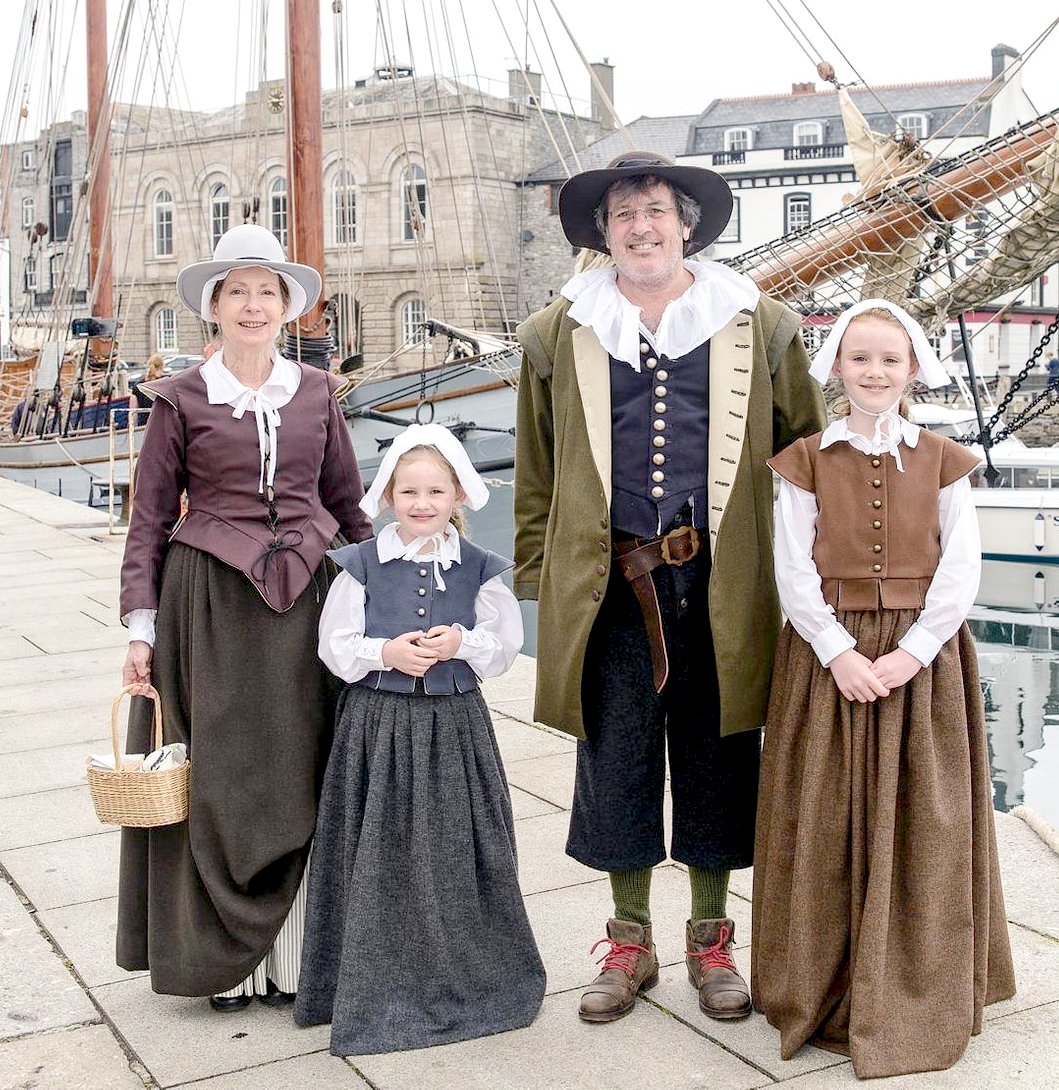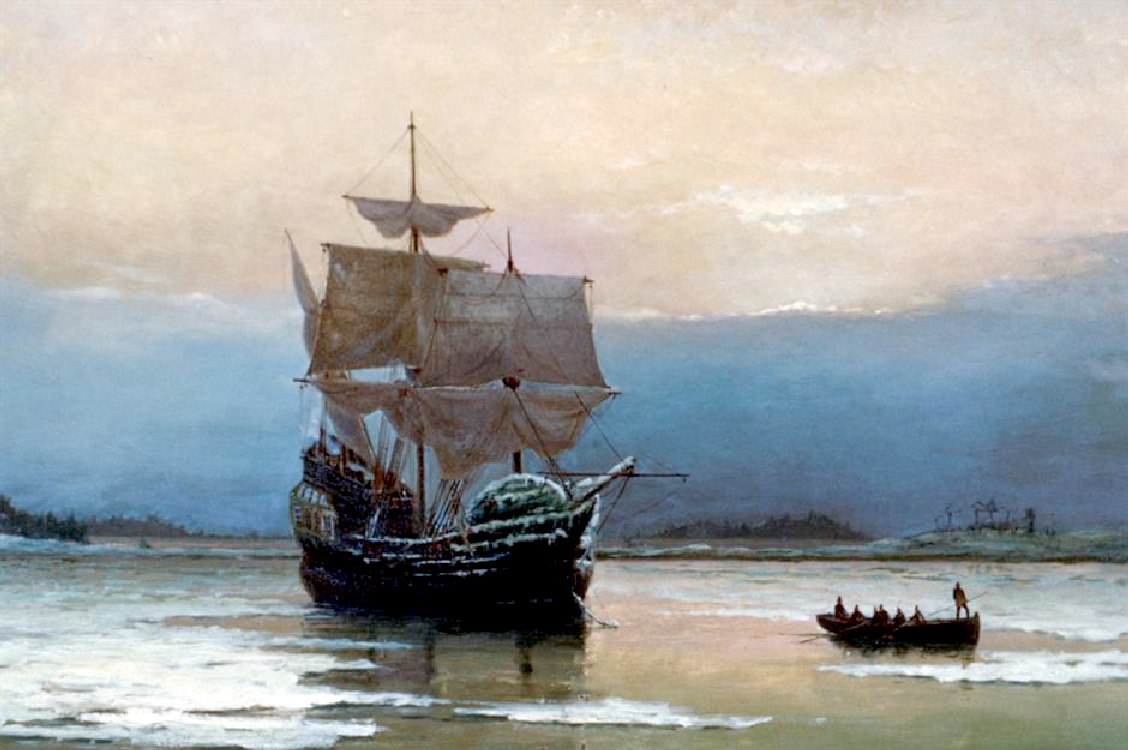
PILGRIMAGES
- Scurrying away from persecution in England, the religious refugees
were betrayed and imprisoned. A fiction based on fact novel, A Spurious Brood outlines a possible explanation for the sabotage of Speedwell, based on the true story of Katherine More, whose children were sent to America on board Mayflower.
In Hornblower and the Atropos, one of the C. S. Forester novels about fictional British naval officer Horatio Hornblower, a treasure ship named Speedwell has sunk in Turkey's Marmorice Bay, and Hornblower's mission is to recover the treasure from the bottom of the bay. Speedwell is also mentioned several times in battle-action scenes in the historical fiction novel, Armada: A Novel, written by Charles Gidley Wheeler and published in 1987.
The Mayflower passengers lived in a cramped space. Many of them were hungry and suffered dire living conditions, and this was only the beginning of their ordeal. The situation worsened when the ship was blown off course by winter storms. Although the Mayflower was bound for Virginia, the ship landed in Cape Cod on 21 November 1620.
On this date, the settlers drew up the Mayflower Compact. This document, signed by 41 men aboard the Mayflower, was an agreement stating they would cooperate “for the general good of the colony”. It established constitutional law and the rule of the majority. Issues would be decided by voting. The Mayflower Compact can be regarded as the foundation of American democracy.
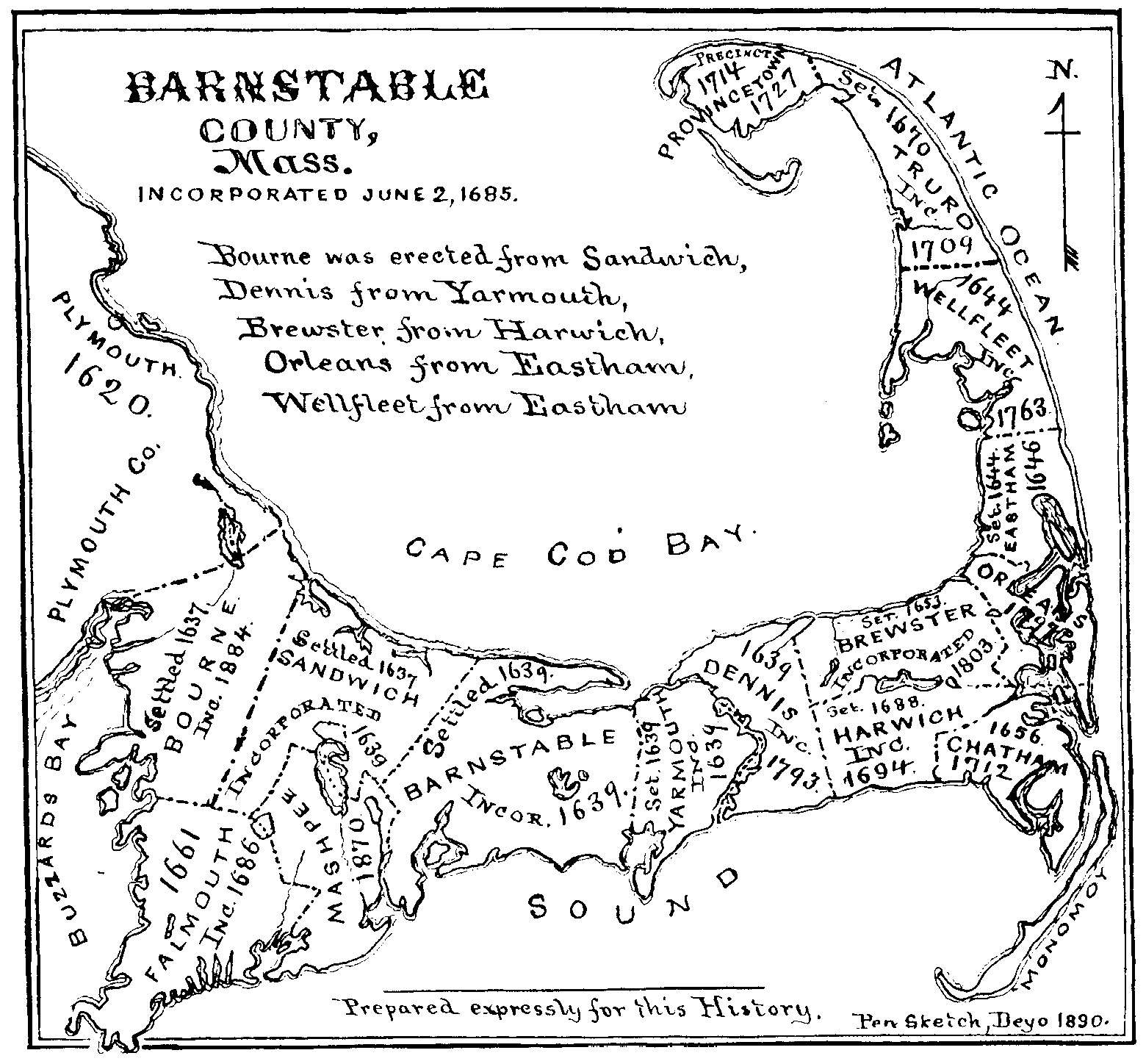
Some days later, Susannah White gave birth to a son aboard the Mayflower: the first English child to be born in New England. His parents named him Peregrine, derived from the latin word for “pilgrim”.
Their need for fresh water and fertile land led a group of Pilgrims to go ashore and explore the area for the first time on 25 November. They spotted a small group of
Native Americans and attempted to follow them, but they got lost in the forest and were hindered by the dense undergrowth. They decided to try a different route and came upon a patch of deforested land which had been used to grow corn. Besides the corn, they also found a number of graves. The village that once stood there, Patuxet, used to be inhabited by the Wampanoag, but it had been deserted after the outbreak of a disease.
The settlers did not expect to meet with resistance if they started their colony here. They left the bleak coast of Cape Cod and arrived in Plymouth Bay, Massachusetts on 26 December 1620.
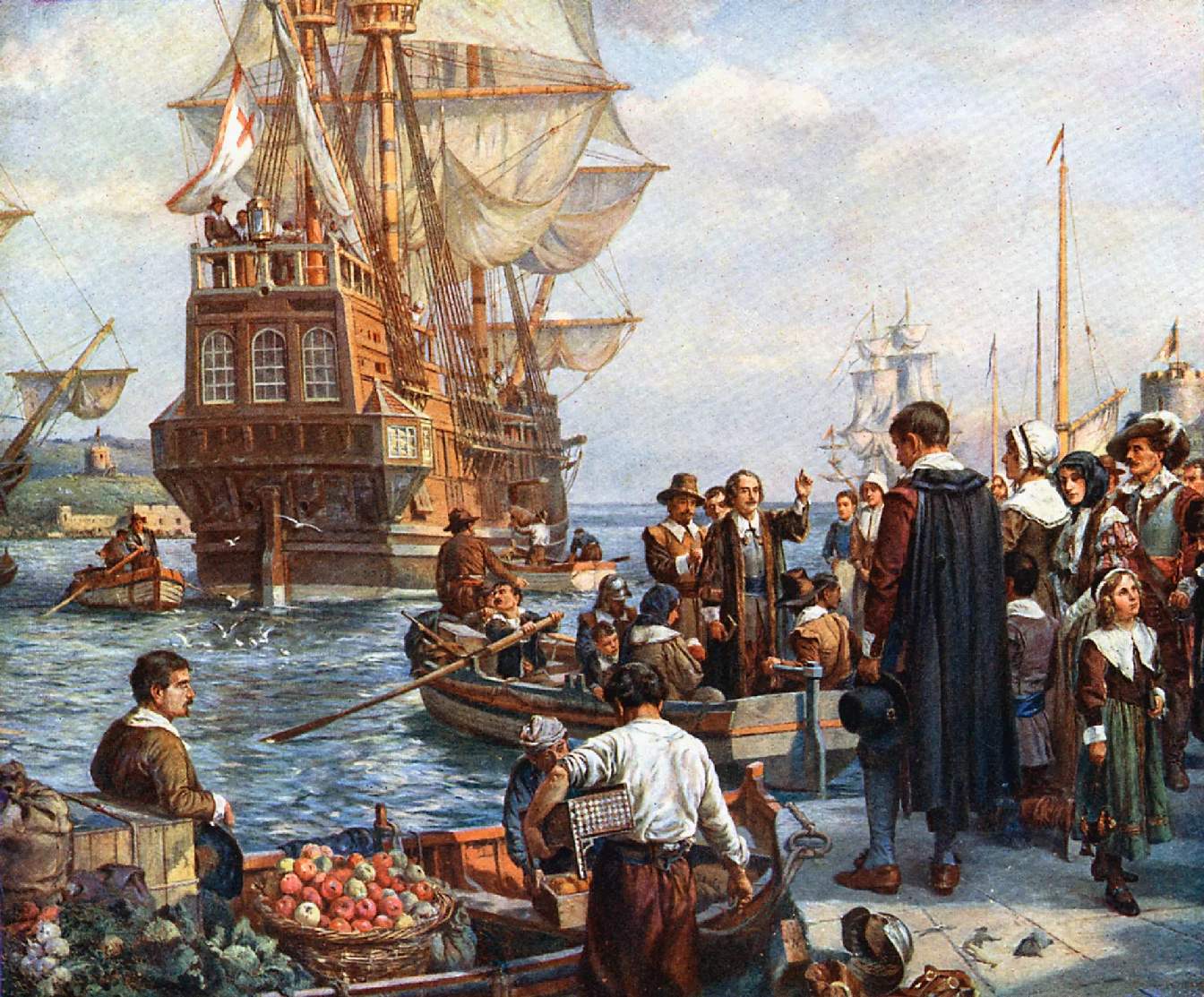
MAYFLOWER
- Loading of the famous ship that was too small to be noted at the Port
of Plymouth in 1620. These are the now famous steps, that are a feature
for visitors to the historic port.
Cape Cod is a geographic cape extending into the Atlantic Ocean from the southeastern corner of mainland Massachusetts, in the northeastern United States. Its historic, maritime character and ample beaches attract heavy tourism during the summer months.
Like Cape Cod itself, the islands south of the Cape have evolved from whaling and trading areas to become resort destinations, attracting wealthy families, celebrities, and tourists. These include the large nearby islands of Nantucket and Martha's Vineyard. Both islands are also famous summer tourist destinations, commonly accessed by ferry from several locations on the cape. The phrases Cape Cod and the Islands and the Cape and Islands are often used to describe the whole region of Barnstable County, Dukes County (including Martha's Vineyard and the smaller Elizabeth Islands), and Nantucket County.
The name "Cape Cod", as it was first used in 1602, applied only to the very tip of the peninsula. It remained that way for 125 years, until the "Precinct of Cape Cod" was incorporated as the Town of Provincetown. No longer in "official" use over the ensuing decades, the name came to mean all of the land east of the Manomet and Scusset rivers – essentially along the line that became the Cape Cod Canal. The creation of the canal separated the majority of the peninsula from the mainland.
NATIVE POPULATION
Cape Cod has been the home of the indigenous Wampanoag for centuries prior to European colonization. They lived from the sea and were accomplished farmers. They understood the principles of sustainable forest management, and were known to light controlled fires to keep the underbrush in check. They helped the Pilgrims, who arrived in the fall of 1620, survive at their new Plymouth Colony.
The Wampanoag gradually lost their lands during the period of European colonization through land cessions and violent conflict with white settlers. The documentary Natives of the Narrowland (1993), narrated by actress Julie Harris, shows the history of the Wampanoag people through Cape Cod archaeological sites.
In 1974, the Mashpee Wampanoag Tribal Council was formed to articulate the concerns of those with Native American ancestry. They petitioned the federal government in 1975 and again in 1990 for official recognition of the Mashpee Wampanoag as a tribe. In May 2007, the Wampanoag tribe was federally recognized.
EUROPEAN EXPLORATION
Cape Cod was a landmark for early explorers. It may have been the "Promontory of Vinland" mentioned by the Norse voyagers (985–1025). The Manomet River area (taken up by the western end of the Cape Cod Canal in the early 20th century) is claimed by some to have been visited by Leif Eiriksson, and a stone wall discovered in Provincetown in 1805 is also claimed to have been built by his younger brother Thorvald Eiriksson around 1007 AD, when the keel of his ship was repaired in the harbor, according to Norse sagas. He was killed later in the same journey, and is said to have been returned to this spot for burial. However, there is no tangible support of the presence of Norse voyagers in Cape Cod, and the view is not generally accepted by archaeologists or historians.
Giovanni da Verrazzano approached it from the south in 1524. He named Martha's Vineyard Claudia, after Claude of France, the wife of Francis I of France. In 1525, Portuguese explorer Estêvão Gomes called it Cabo de la Arenas while sailing under the Spanish crown.
In 1602, Bartholomew Gosnold named the tip Cape Cod, the surviving term and the ninth oldest English place-name in the U.S. Samuel de Champlain charted its sand-silted harbors in 1606, and Henry Hudson landed there in 1609. Captain John Smith noted it on his map of 1614, and at last the Pilgrims entered the "Cape Harbor" and – contrary to the popular myth of Plymouth Rock – made their first landing near present-day Provincetown on November 11, 1620. Nearby, in what is now Eastham, they had their first encounter with Native Americans.
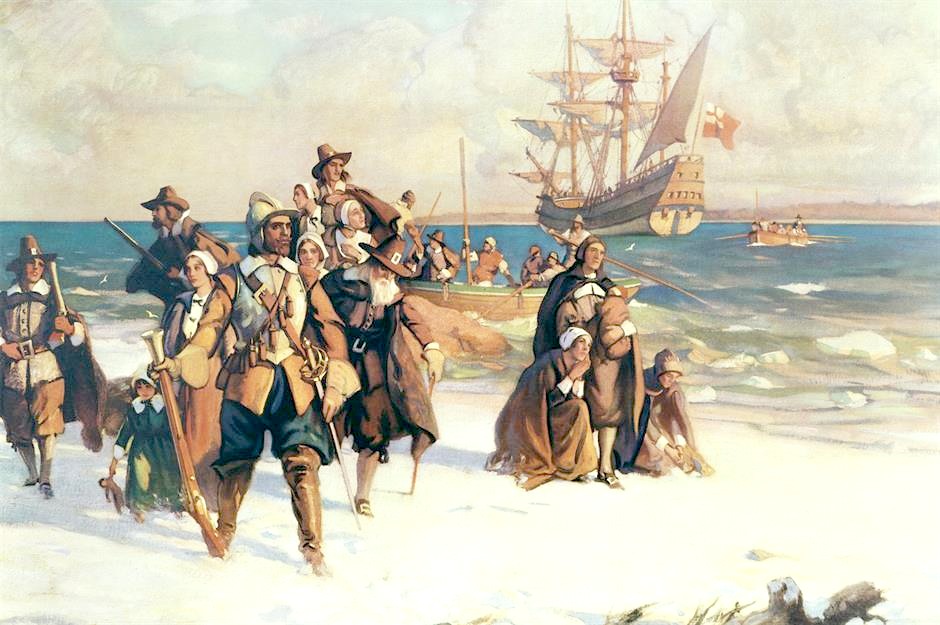
SETTLEMENT
Cape Cod was among the first places settled by Puritan colonists in North America. The Cape's fifteen towns developed slowly, aside from Barnstable (1639), Sandwich (1637), and Yarmouth (1639). The final town to be established on the Cape was Bourne in 1884, breaking off from
Sandwich. Provincetown was a group of huts until the 18th century. A channel from Massachusetts Bay to Buzzards Bay is shown on Southack's map of 1717. The present Cape Cod Canal was slowly developed from 1870 to 1914. The federal government purchased it in 1928.
The Cape's vegetation was depauperate and trees were scarce by the time that Henry Thoreau saw Cape Cod during his four visits over 1849 to 1857, because of early colonial settlement and intensive land use. The settlers heated by fires, and it took 10 to 20 cords (40 to 80 m3) of wood to heat a home, so they cleared most of Cape Cod of timber early on. They planted familiar crops, but these were unsuited to Cape Cod's thin, glacially derived soils. For instance, much of Eastham was planted to wheat. The settlers practiced burning of woodlands to release nutrients into the soil. Improper and intensive farming led to erosion and the loss of topsoil. Farmers grazed their cattle on the grassy dunes of coastal Massachusetts, only to watch "in horror as the denuded sands 'walked' over richer lands, burying cultivated fields and fences." Dunes on the outer Cape became more common, and many harbors filled in with eroded soils.
By 1800, much of Cape Cod's firewood had to be transported by boat from Maine. The paucity of vegetation was worsened by the raising of merino sheep that reached its peak in New England around 1840. The early industrial revolution occurred through much of Massachusetts and Rhode Island, but it mostly bypassed Cape Cod due to a lack of significant water power in the area. The Cape developed as a large fishing and whaling center as a result, and also because of its geographic position. After 1860 and the opening of the American West, farmers abandoned agriculture on the Cape. By 1950, forests had recovered to an extent not seen since the 18th century.
TOURISM
Cape Cod has a year-round population of about 220,000, and it experiences a tourist season each summer, the beginning and end of which can be roughly approximated as Memorial Day and Labor Day, respectively. Many businesses specifically target summer visitors, although the "on season" has been expanding somewhat in recent years due to Indian Summer, reduced lodging rates, the number of people visiting the Cape after Labor Day who have no school-age children, and the
elderly - reducing the true "off season" to six or seven months. In the late 20th century, tourists and owners of second homes began visiting the Cape more and more in the spring and fall, softening the definition of the high season and expanding it somewhat.
Provincetown berths the original East Coast whale watching fleet (Dolphin Fleet) who patrol the Stellwagen Bank National Marine Sanctuary. The fleet guarantee a whale sighting (mostly humpback whale, fin whale, minke whale, sei whale, and the critically endangered North Atlantic right whale) and is the only federally certified operation qualified to rescue whales. Provincetown has also long been known as an art colony, attracting writers and artists. The town is home to the Cape's most attended art museum, the Provincetown Art Association and Museum.
Cape Cod is a popular destination for beachgoers from all over, with 559.6 miles (900.6 km) of coastline.
Beaches - both public and private - are easily accessible. The Cape has upwards of sixty public beaches, many of which offer parking for non-residents for a daily fee (in summer). The Cape Cod National Seashore has 40 miles (64 km) of sandy beach and many walking paths.
Cape Cod is also popular for its outdoor activities, such as beach walking, biking, boating, fishing, go-karts, golfing, kayaking, miniature golf, and unique shopping. There are 27 public, daily-fee golf courses and 15 private courses on Cape Cod.[49] Bed and breakfasts or vacation houses are often used for lodging.
Each summer, the Naukabout Music Festival is held at the Barnstable County Fair Grounds located in East Falmouth, typically during the first weekend of August. The festival features local, regional, and national talent, along with food, arts, and family-friendly activities. Some particularly well-known Cape products and industries include cranberries, shellfish (particularly oysters and clams), and lobstering.
FISHING
Cape Cod is known around the world as a spring-to-fall destination for sport anglers. Among the species most widely pursued are striped bass, bluefish, bluefin tuna, false albacore (little tunny), bonito, tautog, flounder and fluke. The Cape Cod Bay side of the Cape, from Sandwich to Provincetown, has numerous harbors, saltwater creeks, and shoals that hold bait fish and attract the larger game fish, such as striped bass, bluefish and bluefin tuna.
The outer edge of the Cape, from Provincetown to Falmouth, faces the open Atlantic from Provincetown to Chatham, and then the more protected water of Nantucket and Vineyard Sounds, from Chatham to Falmouth. The bays, harbors and shoals along this coastline also provide a robust habitat for game species, and during the late summer months warm-water species such as mahi-mahi and marlin will also appear on the southern edge of Cape Cod's waters. Nearly every harbor on Cape Cod hosts sport fishing charter boats, which run from May through October.
One of the most popular fishing spots on the East Coast is the Cape Cod Canal. Striped bass, especially, in season attract anglers from far and wide. A large part of the attraction involves ease of access.
JAWS
The famous summer blockbuster featuring a giant shark called Jaws, was filmed at Martha's Vienyard by
Steven Speilberg and Peter Benchley in 1975. The town of Amity closely resembles the description of those at Cape Cod.
LINKS,
CONTACTS & REFERENCE
https://
